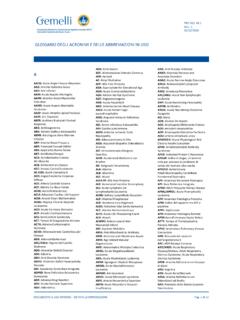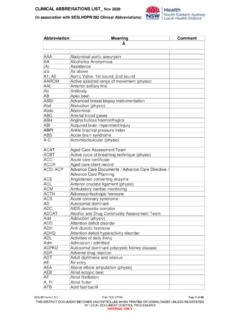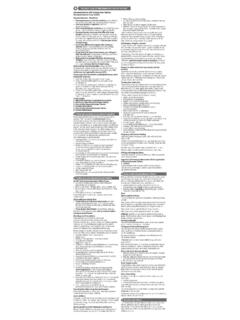Transcription of UK Interim Clinical Commissioning Policy: Therapies for ...
1 Consider the Clinical suitability of antiviral or neutralising monoclonal antibody. PF-07321332/ritonavir and sotrovimab are first-line options and remdesivir is second-line. Molnupiravir should be considered a third-line treatment options. (see page 3 for further information on choosing between antiviral and nMAB).Antiviral PathwaynMAB PathwayUK Interim Clinical Commissioning Policy: Therapies for symptomatic non-hospitalised patients with COVID-19 Consider access to this Clinical pathway for patients under the following conditions.
2 -Onset of symptoms of COVID-19 within the last 5 days (for PF-07321332/ritonavir*, sotrovimab and molnupiravir) or 7 days (for remdesivir), remains symptomatic and with no signs of Clinical recovery-SARS-CoV-2 infection is confirmed by either PCR or lateral flow test (registered via )-The patient is a member of a ?highest? risk group (see page 2)-The patient is not hospitalised for COVID-19 and is not requiring new supplemental oxygen specifically for the management of COVID-19 symptomsAge under 18 years?Seek paediatric MDT adviceYesAge 12 years and above and at least 40Kg?
3 Take baseline serology where possible (for surveillance)YesPregnant or likely to be?Seek obstetric adviceContraception advice given (see page 4) and likely to be followed?NoNoSpeciality advice supports PF-07321332/ritonavir treatment?(see pages 4-5)YesYesIs the patient on any contraindicated medication for PF-07321332/ ritonavir (see pages 6-7)YesProceed to treatment with PF-07321332/ritonavirNoProceed to treatment with remdesivirYesPatient-specific factors** rendering treatment not possible?Patient-specific factors** rendering treatment not possible?
4 NoProceed to treatment with sotrovimabNoHistory of advanced decompensated cirrhosis/CKD stage 3-5?NoPatient-specific factors** render treatment not possible?NoHave PF-07321332/ ritonavir and remdesivir been considered? Enter antiviral pathwayPatients (aged 18 years and over) should only be treated with molnupiravir when treatment with PF-07321332/ritonavir, remdesvir and sotrovimab is contraindicated and onset of symtoms is within 5 days. YesNoYesSymptom onset within 7 days?Seek specialty advice*Formal name: PF-07321332 (may also be known as nirmatrelvir) plus ritonavir (Paxlovid).
5 Referred to in policy as PF-07321332 (nirmatrelvir) plus ritonavir**Treatment commencement may be extended up to a maximum of 7 days from symptom onset if clinically indicated (this would be off-label)**Patient-specific factors could include needle phobia and inability to attend for intravenous treatment (for sotrovimab and remdesivir) or swallowing difficulties with oral tablets (PF-07321332/ritonavir) and molnupiravir)Clinicians are encouraged to proactively support recruitment into trials developing further evidence in the treatment of COVID-19 Unable to treatNoUnable to treatNoSymptom onset within 5 days?
6 **Age 12 years and above and at least 40Kg?favour antiviral treatmentYesNoSymptom onset within 5 days?**YesVersion 1. 27 January 2022. Not valid if printed1No (male or no childbearingpotential)YesConsider sotrovimab as alternative first-line treatmentNoYesNoPF-07321332/ritonavirfav ouredNoNoYesNoCohortDefinitionClinical Guide: The 'highest risk' cohort for access to treatmentThe following cohorts were determined by an independent advisory group commissioned by the Department of Health and Social Care (DHSC). Patients in these cohorts are determined to be at highest risk of adverse outcomes from COVID-19 and are to be prioritised for treatment with nMABs and 's syndromeAll patients with Down's syndromePatients with a solid cancerActive metastatic cancer and active solid cancers (at any stage)-All patients receiving chemotherapy within the last 3 months-Patients receiving group B or C chemotherapy 3-12 months prior (see Appendix 3)
7 -Patients receiving radiotherapy within the last 6 monthsPatients with haematological disease and stem cell transplant recipients-Allogeneic haematopoietic stem cell transplant (HSCT) recipients in the last 12 months or active graft vs host disease (GVHD) regardless of time from transplant (including (HSCT for non-malignant diseases)-Autologous HSCT recipients in the last 12 months (including (HSCT for non-malignant diseases)-Individuals with haematological malignancies who have-received chimaeric antigen receptor (CAR)-T cell therapy in the last 24 months.))
8 Or-radiotherapy in the last 6 months-Individuals with haematological malignancies receiving systemic anti-cancer treatment (SACT) within the last 12 months except patients with chronic phase chronic myeloid leukaemia (CML) in molecular response; or first or second line tyrosine kinase inhibitors (TKI)-All patients with myeloma (excluding MGUS) or chronic B-cell lymphoproliferative disorders ( lymphocytic leukaemia, follicular lymphoma) or myelodysplastic syndrome (MDS) who do not fit the criteria patients with sickle cell with non-malignant haematological disorder ( anaemia or paroxysmal nocturnal haemoglobinuria) receiving B-cell depleting systemic treatment ( , anti-thymocyte globulin [ATG] andalemtzumab)
9 Within the last 12 with renal disease-Renal transplant recipients (including those with failed transplants within the past 12 months), particularly those who: -Received B cell depleting therapy within the past 12 months (including alemtuzumab, rituximab [anti-CD20], anti-thymocyte globulin)-Have an additional substantial risk factor which would in isolation make them eligible for nMABs or oral antivirals-Not been vaccinated prior to transplantation-Non-transplant patients who have received a comparable level of immunosuppression-Patients with chronic kidney stage (CKD) 4 or 5 (an eGFR less than 30 ml/ )
10 Without immunosuppressionPatients with liver diseasePatients with cirrhosis Child?s-Pugh class B and C (decompensated liver disease)-Patients with a liver transplant-Liver patients on immune suppressive therapy (including patients with and without liver cirrhosis)Patients with cirrhosis Child?s-Pugh class A who are not on immune suppressive therapy (compensated liver disease)Patients with immune-mediated inflammatory disorders-IMID treated with rituximab or other B cell depleting therapy in the last 12 months-IMID with active/unstable OR stable disease on corticosteroids (equivalent to ?)















